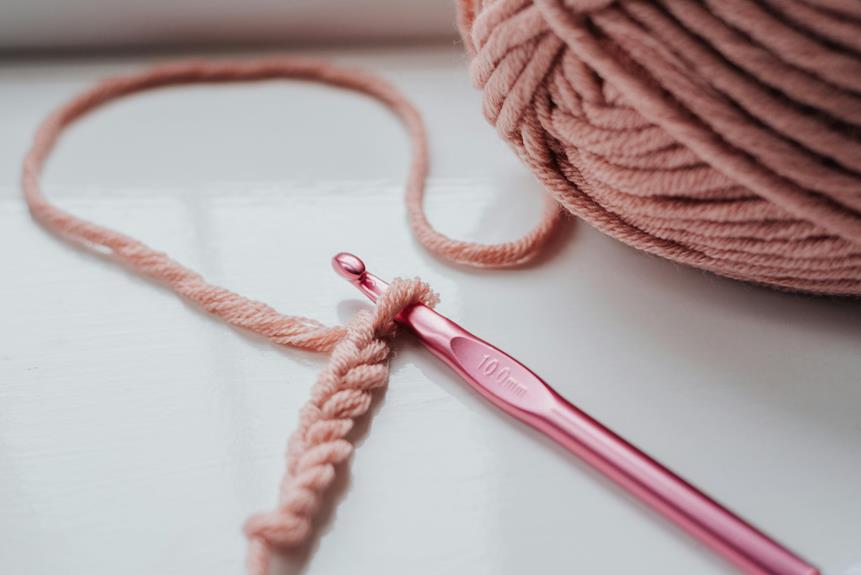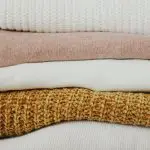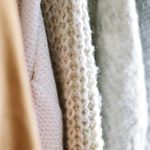When you think about the clothes you wear in colder climates, have you considered how chenille influences insulation? Its unique structure traps air, creating insulation that can keep you warm without the bulkiness of heavier fabrics. The soft, fuzzy texture not only feels good against your skin but also plays a practical role in temperature regulation. But is it all advantages, or does chenille have some limitations that you should know about? Exploring these aspects could change your approach to winter clothing choices.
Table of Contents
What Is Chenille?
Chenille is a textile made from soft and velvety yarn, often used to create cozy, tactile fabrics in clothing and home décor. When you touch chenille, you immediately notice its plush texture, which can evoke a sense of warmth and comfort. This unique yarn is typically produced by adding a fuzzy pile to a core yarn, giving it that distinct, velvety feel.
You might find chenille in various forms, from blankets and cushions to sweaters and scarves. Its versatility allows you to incorporate the luxurious feel into multiple aspects of your life. In clothing, chenille feels gentle against your skin and adds an element of coziness, making it perfect for fall and winter wear.
When selecting chenille garments, consider how its softness enhances not just comfort but the overall aesthetic of your outfit. The vibrant colors and rich textures make it a popular choice for both casual and formal styles. You'll appreciate how chenille elevates your wardrobe, bringing together style and comfort effortlessly. As you explore this fabric, you'll find it's more than just a cozy option—it's a timeless addition to your textile collection.
Chenille Fabric Structure
When you think about chenille fabric, its unique yarn composition stands out immediately.
The loop and pile design not only gives it a distinct look but also plays a key role in how it insulates.
Let's explore how these features contribute to the fabric's thermal properties.
Unique Yarn Composition
Crafted from a unique yarn structure that features tufted piles, chenille fabric enhances insulation by trapping air within its soft, fuzzy texture. This yarn composition sets chenille apart from other textiles, providing you with both comfort and warmth. The tufts create a multi-dimensional feel, contributing to the overall thermal properties.
Here's a quick breakdown of some key characteristics of chenille yarn composition:
| Characteristic | Description |
|---|---|
| Softness | Chenille's texture is luxuriously soft, appealing to touch. |
| Thickness | The yarn is thicker than traditional fabrics, aiding insulation. |
| Durability | Chenille offers resilience, maintaining its shape over time. |
| Versatility | This fabric is used in various clothing types, from sweaters to blankets. |
Loop and Pile Design
The loop and pile design of chenille fabric creates a unique texture that effectively traps warm air, enhancing insulation in your clothing.
This innovative construction features loops of yarn that stand upright, forming a plush surface. When you wear chenille, the loops create air pockets that act as barriers against cold temperatures.
As you move, the loops compress and release, allowing for flexibility while maintaining warmth. This dynamic not only improves comfort but also makes chenille suitable for various activities, whether you're lounging at home or out and about.
The pile design also adds a soft, cushioned feel against your skin, further elevating your overall experience.
Additionally, this fabric's ability to retain its shape means that it won't lose its insulating properties over time, making it a dependable choice for your wardrobe.
Whether you opt for a cozy blanket or a stylish sweater, the loop and pile design ensures that you stay warm and comfortable in chilly conditions.
Ultimately, when you choose chenille for your clothing, you're not only embracing its aesthetic appeal but also benefiting from its unique structure that plays a crucial role in insulation.
Thermal Properties Explained
The structure of chenille plays a crucial role in retaining heat. With its unique looped pile design, the fabric creates tiny air pockets that trap warmth. When you wear chenille clothing, these air pockets help form a barrier against the cold, keeping you snug and comfortable.
Additionally, chenille is typically made from synthetic fibers, like polyester, which add to its insulating capabilities. These fibers often have lower thermal conductivity compared to natural fibers, meaning they don't transfer heat away from your body as quickly. So, when you snuggle into a chenille sweater or blanket, you're not only wrapped in softness but also cocooned in warmth.
Another factor worth noting is moisture management. Chenille's ability to wick away moisture can help you maintain a stable body temperature. It keeps sweat at bay, ensuring that you don't cool off too quickly in colder conditions.
Insulation Basics
Insulation in clothing works by trapping air within the fabric, which helps maintain your body heat in cold conditions. This trapped air acts as a barrier against the cold, preventing your body's warmth from escaping. The effectiveness of insulation depends on several factors, including the type of material used, the fabric's thickness, and construction.
Here's a quick comparison of common insulation materials you might encounter:
| Material | Pros | Cons |
|---|---|---|
| Down | Excellent warmth-to-weight ratio | Loses insulation when wet |
| Synthetic | Retains warmth when damp | Heavier than down |
| Wool | Naturally moisture-wicking | Can be itchy for some users |
| Fleece | Soft and lightweight | Less effective in extreme cold |
| Chenille | Soft and comfortable | Varies in insulation efficiency |
When choosing clothing for cold weather, consider these attributes carefully. By understanding insulation basics, you can make better decisions about what to wear, ensuring you stay warm and comfortable throughout your outdoor adventures.
Chenille's Thermal Properties
Chenille offers a unique blend of softness and comfort, which can influence its thermal properties in clothing. When you wear chenille, you'll notice how the fabric creates a barrier against the cold while providing a cozy feel. Its structure contributes to insulation in several ways, making it a favored choice for snug apparel.
- Air Retention: The looped texture traps air, creating pockets of warmth that help keep you insulated.
- Moisture Absorption: Chenille can absorb moisture, which prevents dampness and helps regulate body temperature.
- Lightweight Nature: Despite its warmth, chenille remains lightweight, allowing for ease of movement without sacrificing comfort.
- Versatile Thickness: You can find chenille fabrics in various thicknesses, enabling you to choose the appropriate level of insulation for different climates.
This combination of features makes chenille a smart choice for anyone seeking warmth without bulk. Whether you're lounging at home or heading out, the thermal properties of this fabric make it an essential element in your wardrobe.
Benefits of Chenille in Clothing
When you choose chenille in your clothing, you'll enjoy unmatched softness and comfort against your skin.
Its enhanced thermal properties make it an excellent choice for staying warm without sacrificing style.
You'll find that chenille not only feels great but also keeps you cozy in chilly weather.
Softness and Comfort
You'll love how chenille's plush texture elevates the softness and comfort of your clothing, making it a perfect choice for cozy outfits. When you slip into chenille, you immediately experience a luxurious sensation that wraps you in warmth without feeling heavy.
- Gentle against the skin: Chenille's velvety fibers provide a soft barrier that feels wonderful, reducing irritation and making it suitable for sensitive skin.
- Breathable: Contrary to what you might think, chenille allows for some airflow, which helps keep you comfortable throughout the day without overheating.
- Versatile styles: You can find chenille in various clothing types, from sweaters to loungewear, ensuring you can enjoy comfort whether you're dressing up or down.
- Easy maintenance: Chenille is generally machine washable and retains its plush texture and color, so you won't have to sacrifice comfort for convenience.
With these qualities, chenille truly stands out as a fabric that prioritizes your comfort while adding a touch of elegance to your outfits.
Enhanced Thermal Properties
Experiencing the softness of chenille is just the beginning, as its unique fiber structure also contributes significantly to its enhanced thermal properties, making it an excellent choice for keeping you warm. The plush texture of chenille traps air, creating insulating pockets that hold heat close to your body. This means you can step out into cold weather without worrying about losing warmth.
Moreover, because chenille fibers are thicker, they provide more surface area for insulation than traditional fabrics, enhancing your overall comfort. You'll notice that even during chilly days, you'll feel snug and cozy when dressed in chenille clothing. It's like embracing a soft, warm blanket.
Another benefit is that chenille is breathable, so while it keeps you warm, it also allows moisture to escape. This helps regulate your body temperature, preventing you from overheating. That means you can stay comfortable whether you're curling up on the couch or heading out for a winter stroll.
In short, wearing chenille not only offers unparalleled softness but also ensures you're wrapped in a cocoon of warmth, making it an excellent addition to your cold-weather wardrobe.
Limitations of Chenille
While chenille offers a plush texture, it also comes with notable limitations in insulation performance compared to other fabrics. If you're considering chenille for your clothing choices, it's important to be aware of these drawbacks.
1. Reduced Breathability: Unlike lighter fabrics, chenille can trap heat and moisture, making it less suitable for high-intensity activities or warmer climates.
2. Weight and Thickness: Chenille's heft can make layered clothing feel bulky, hindering mobility. This can be a disadvantage for those who need freedom of movement.
3. Moisture Retention: Chenille tends to absorb moisture rather than wick it away, leading to a damp feeling during prolonged wear. This can disrupt your comfort, especially in cooler conditions.
4. Fragility in Insulation Over Time: Chenille fibers can break down or lose their plushness with repeated washing, diminishing their ability to insulate effectively.
Practical Tips for Wearing Chenille
When wearing chenille, opt for layering techniques that manage heat retention while allowing for comfort and mobility. Since chenille has a unique texture, it's essential to choose the right base layer. A lightweight, moisture-wicking fabric underneath helps regulate body temperature, preventing overheating.
Next, consider your outer layer. A fitted or slightly loose structure is ideal; it allows air circulation without sacrificing warmth. Avoid bulky styles that can make movement cumbersome. If it's chilly outside, a light jacket or blazer over your chenille sweater can add an extra barrier against the cold.
Accessorizing wisely also makes a difference. Scarves and hats can amplify warmth while keeping your look stylish. Choose pieces that complement the softness of chenille, opting for smooth fabrics to prevent irritation.
Lastly, don't forget about footwear. Pair your chenille outfit with comfortable shoes that offer good support, especially if you'll be on your feet. A stylish pair of ankle boots or cushioned sneakers can complete your look while ensuring comfort.
Frequently Asked Questions
Can Chenille Be Blended With Other Fabrics for Insulation?
Yes, you can blend chenille with other fabrics for insulation. Combining it with materials like polyester or wool enhances warmth and comfort. Experimenting with blends can create unique textures and improve performance in colder conditions.
How Do Detergents Affect Chenille's Insulating Properties?
Detergents can degrade chenille's fibers, reducing its insulating properties. You'll notice that harsh chemicals strip away the softness and warmth, so it's best to use gentle detergents to maintain its effectiveness and durability.
Is Chenille Suitable for Outdoor Activities During Winter?
Yes, chenille's softness and warmth make it suitable for outdoor winter activities, but you should layer it with moisture-wicking fabrics. Just ensure it's not the only layer to stay comfortable and dry.
Does the Thickness of Chenille Impact Insulation Effectiveness?
Yes, the thickness of chenille can impact insulation effectiveness. Thicker chenille often traps more air, enhancing warmth. However, too much thickness might reduce breathability, so finding the right balance is key for optimal comfort.
Can Chenille Be Recycled, and Does It Maintain Insulation?
Yes, you can recycle chenille, but the process might affect its integrity. While it's possible for the recycled material to retain some insulation properties, they often won't match the original quality or effectiveness.
- How Does Ring Spun Cotton Affect Garment Fit and Shape Retention? - August 13, 2024
- What Are the Challenges in Producing Ring Spun Cotton? - August 13, 2024
- Is Ring Spun Cotton Suitable for Plus-Size Clothing? - August 13, 2024







